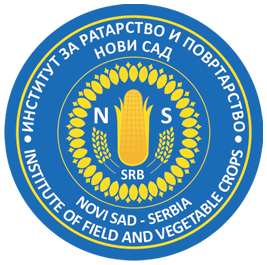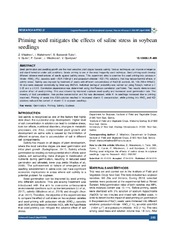Priming seed mitigates the effects of saline stress in soybean seedlings
2020
Аутори
Miladinov, Zlatica
Maksimović, Ivana

Balešević-Tubić, Svetlana

Đukić, Vojin

Čanak, Petar
Miladinović, Jegor

Đorđević, Vuk

Чланак у часопису (Објављена верзија)

Метаподаци
Приказ свих података о документуАпстракт
Seed germination and seedling growth are the most sensitive plant stages towards salinity. Various techniques can improve emergence and stand formation under salt conditions. Seeds priming is one of the most frequently used technique. Seed priming could develop different defence mechanisms of seeds against salinity stress. This experiment aims to examine the seed priming into potassium nitrate - KNO3 (1%), ascorbic acid - ASA (100mgl(-1)) and potassium chloride - KCl (1%) solutions, that may reduce harmful effects of salinity stress. Salinity was imposed by treatment of seeds with different concentrations of NaCl [0 (control), 50, 100, 200m MNaCl]. All data were analysed statistically by three-way ANOVA. Individual testing of probability was carried out using Tukey's method p lt = 0.05 and p lt = 0.01. Correlation dependence was determined using the Pearson correlation coefficient. Test results demonstrated positive effect of seed priming. This was showed by improved soybean seed qua...lity and increased seed germination rate. The intensity of lipid peroxidation, free proline concentration and Na+ was decreased, while K+ in seedlings increased due to priming treatment. Priming of seeds into ASA solution resulted in increased vitamin C concentration, while priming into KNO3 and KCl solutions reduced the content of vitamin C in soybean seedlings.
Кључне речи:
Germination / Priming / Salinity / SoybeanИзвор:
Legume Research, 2020, 43, 2, 263-267Издавач:
- Agricultural Research Communication Centre, Karnal
Финансирање / пројекти:
- Интердисциплинарни приступ стварању нових сорти соје и унапређењу технологије гајења и дораде семена (RS-MESTD-Technological Development (TD or TR)-31022)
DOI: 10.18805/LR-469
ISSN: 0250-5371
WoS: 000534477100018
Scopus: 2-s2.0-85085756880
Колекције
Институција/група
FiVeRTY - JOUR AU - Miladinov, Zlatica AU - Maksimović, Ivana AU - Balešević-Tubić, Svetlana AU - Đukić, Vojin AU - Čanak, Petar AU - Miladinović, Jegor AU - Đorđević, Vuk PY - 2020 UR - http://fiver.ifvcns.rs/handle/123456789/1992 AB - Seed germination and seedling growth are the most sensitive plant stages towards salinity. Various techniques can improve emergence and stand formation under salt conditions. Seeds priming is one of the most frequently used technique. Seed priming could develop different defence mechanisms of seeds against salinity stress. This experiment aims to examine the seed priming into potassium nitrate - KNO3 (1%), ascorbic acid - ASA (100mgl(-1)) and potassium chloride - KCl (1%) solutions, that may reduce harmful effects of salinity stress. Salinity was imposed by treatment of seeds with different concentrations of NaCl [0 (control), 50, 100, 200m MNaCl]. All data were analysed statistically by three-way ANOVA. Individual testing of probability was carried out using Tukey's method p lt = 0.05 and p lt = 0.01. Correlation dependence was determined using the Pearson correlation coefficient. Test results demonstrated positive effect of seed priming. This was showed by improved soybean seed quality and increased seed germination rate. The intensity of lipid peroxidation, free proline concentration and Na+ was decreased, while K+ in seedlings increased due to priming treatment. Priming of seeds into ASA solution resulted in increased vitamin C concentration, while priming into KNO3 and KCl solutions reduced the content of vitamin C in soybean seedlings. PB - Agricultural Research Communication Centre, Karnal T2 - Legume Research T1 - Priming seed mitigates the effects of saline stress in soybean seedlings EP - 267 IS - 2 SP - 263 VL - 43 DO - 10.18805/LR-469 ER -
@article{
author = "Miladinov, Zlatica and Maksimović, Ivana and Balešević-Tubić, Svetlana and Đukić, Vojin and Čanak, Petar and Miladinović, Jegor and Đorđević, Vuk",
year = "2020",
abstract = "Seed germination and seedling growth are the most sensitive plant stages towards salinity. Various techniques can improve emergence and stand formation under salt conditions. Seeds priming is one of the most frequently used technique. Seed priming could develop different defence mechanisms of seeds against salinity stress. This experiment aims to examine the seed priming into potassium nitrate - KNO3 (1%), ascorbic acid - ASA (100mgl(-1)) and potassium chloride - KCl (1%) solutions, that may reduce harmful effects of salinity stress. Salinity was imposed by treatment of seeds with different concentrations of NaCl [0 (control), 50, 100, 200m MNaCl]. All data were analysed statistically by three-way ANOVA. Individual testing of probability was carried out using Tukey's method p lt = 0.05 and p lt = 0.01. Correlation dependence was determined using the Pearson correlation coefficient. Test results demonstrated positive effect of seed priming. This was showed by improved soybean seed quality and increased seed germination rate. The intensity of lipid peroxidation, free proline concentration and Na+ was decreased, while K+ in seedlings increased due to priming treatment. Priming of seeds into ASA solution resulted in increased vitamin C concentration, while priming into KNO3 and KCl solutions reduced the content of vitamin C in soybean seedlings.",
publisher = "Agricultural Research Communication Centre, Karnal",
journal = "Legume Research",
title = "Priming seed mitigates the effects of saline stress in soybean seedlings",
pages = "267-263",
number = "2",
volume = "43",
doi = "10.18805/LR-469"
}
Miladinov, Z., Maksimović, I., Balešević-Tubić, S., Đukić, V., Čanak, P., Miladinović, J.,& Đorđević, V.. (2020). Priming seed mitigates the effects of saline stress in soybean seedlings. in Legume Research Agricultural Research Communication Centre, Karnal., 43(2), 263-267. https://doi.org/10.18805/LR-469
Miladinov Z, Maksimović I, Balešević-Tubić S, Đukić V, Čanak P, Miladinović J, Đorđević V. Priming seed mitigates the effects of saline stress in soybean seedlings. in Legume Research. 2020;43(2):263-267. doi:10.18805/LR-469 .
Miladinov, Zlatica, Maksimović, Ivana, Balešević-Tubić, Svetlana, Đukić, Vojin, Čanak, Petar, Miladinović, Jegor, Đorđević, Vuk, "Priming seed mitigates the effects of saline stress in soybean seedlings" in Legume Research, 43, no. 2 (2020):263-267, https://doi.org/10.18805/LR-469 . .


